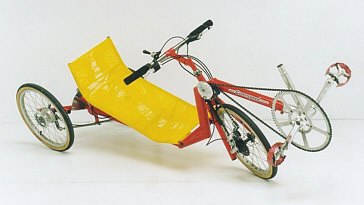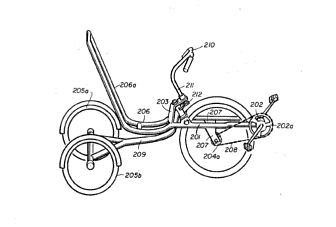Prior Art
Early Experiments
Above is my first lean steer trike prototype. It was made from some surplus pipe that was lying around the shed. While it did end up being too heavy, the whole idea was to build something I could experiment with to gain some insight into the effects of lean steer geometry. In this trike the steering and tilting were directly connected, so it suffered from bump steer. However an even more pernicious problem occurred when the road you were riding on had any sort of camber -- which most well engineered roads do -- the trike would tend to steer towards the road center. So in order to drive straight, the rider always needed to lean slightly away from the center of the road. At higher speed this caused oscillations or shimmy that ultimately effected the high speed stability of the design. After observing this behavior first hand, I came to realize that a successful leaning trike must have a tilting mechanism that is independent of the steering.
Inspiration
Much of my initital inspiration for Jetrike came from seeing Bram Smit's <www.fastfwd.nl> tilting trike.
On his site, he reports that his trike was difficult to balance, and you will notice he added a caliper brake to the rocker arm to manually lock the tilt mechanism when stationary. My simulation geometry would appear to confirms this. You will notice that while most angles are 90° and the lengths are about right, Angle A is about 120°. After estimating his setup and simulating it, I found that the seat on his trike actually moves in a collinear path towards the center contact patch by 12mm on a 30° tilt. Without the tilt locking caliper brake, one would think this trike would be harder to balance than a two wheeled inline recumbent with a similar wheelbase. People who have actually ridden it report that its very good cornering characteristics more than make up for requiring a tilt lock to get started. Nevertheless, if you were planning to replicate this design, I would make the swing arms horizontal.
Bram Smit credits his inspiration as comming from a Spanish builder, Carlos Calleja <www.moebius.es/ccalleja/> and his three wheeled motorcycle prototype. Carlos was granted US patent 5611555 for his invention in 1997.
From what I can tell, Carlos' rocker arm has a locking mechanism that is de-activated by motion. So when the bike is moving it is unlocked and moves freely, but as the bike becomes stationary the mechanism locks automatically. He also has a suspension link to the rocker arm pivot.
Often swing arm designs are referred to as Calleja designs, but I believe this is incorrect. The swing arm rear end Calleja used was actually invented and patented by Curtis L. Prince (see below) in 1987. Meaning no disrespect to Carlos, I think these swing arm designs should be referred to as Prince designs, in deference to their original inventor. Only the tilt locking mechanism and suspension configuration should be credited to Calleja. Key Influences
Some other designs that influenced Jetrike include...
The Hipparion is a front wheel drive (FWD) lean-steer trike built by Esko Meriluoto <personal.eunet.fi/pp/davinci/osa5eng.html>. This trike has negative trail and a steering dampener to prevent dynamic instability (shimmy) at high speeds. The Python is a two wheeled center steer bike invented by Jürgen Mages (pictured above) <www.python-lowracer.de>. Despite having negative trail, the Python geometry provides dynamic stability by generating a self-centering effect. I believe that free to castor (FTC) is actually at work here. The Speculoos is a FWD two wheeled recumbent bike developed by Laurent Dechenne <les-velos-de-laurent.skynetblogs.be>. It features positive trail, but according to Laurent, to reduce pedal induced steering the bottom bracket height must be level to the seat height and the pivot angle should be between 55° and 60°. This parallelogram based FWD tilting trike was developed by Paul Sims <www.greenspeed.com.au/australia/paul> (son of legendary trike builder Ian Sims of Greenspeed). He built it to compete in a 24 hour HPV challenge. The parallelogram based tilt geometry required a caliper brake to manually lock the tilt mechanism when stationary. Patent US4887829 (full) This is the earliest reference I have found to the type of tilting mechanism used in the Jetrike design. This patent was filed by its inventor Curtis L. Prince in 1987. Seeing we are now in 2007 this patent has actually expired, so we are all free to use his invention in future designs. You will notice that the tie rods between the swing arms and rocker arms have shock absorbers. Patent US5611555 This is the patent filed in 1994 by the Spanish builder Carlos Calleja for his three wheeled motorcycle design. His patent claims cover the motion de-activated tilt lock and suspension mechanisms.
Patent US3964563 (full) Ross Cowie on the Yahoo tilting group <groups.yahoo.com/group/tilting> brought this patent to my attention. Filed by Carling D. Allen in 1975, it covers a swing arm design not unlike the Prince design, only using other means including one with pulleys (left) and others using gears to generate the counter action in the opposing swing arm. Messerschmitt "Kurvenleger" Kevin Gill on the Yahoo tilting group <groups.yahoo.com/group/tilting> sent me this image. The original caption reads... A "Kurvenleger" prevented the occupants from slipping out of their seats when going around turns. In 1956, the Messerschmitt studies department became involved in the further development of the MOBO concept built in the United States (this frontal view shows the chassis "banked" in a left turn.
Messerschmitt designed this Tilter with trailing/leading arms in 1956. This is the earliest swing arm design I am awear of, but it is unclear from the photo, what form of counter action is employed by this design.
Other Tilting Trikes
Patent US3981516 This patent was filed by a Swedish builder, Björn Häggkvist in 1975. It is an interesting FWD design where the seat and drive train form one frame, and the delta rear end another. The steering pivot itself is driven by a sprocket on the handle bar stem. This approach eliminates pedal induced steering, but the problem with this design, like many other lean steer trikes is that the rider center of gravity (CoG) appears to move outward as the trike turns. Patent US4432561 (full) This patent was filed by Roger H. Feikema and Harry J. Bakker in 1982. Trailmate <www.trailmate.com> manufacturers these under the name 'Fun Cycle' and 'Banana Peel' and they are marketed as an industrial bike for the tourist bike rental market. A British company Trixstar <www.trixstar.co.uk> also made an identical looking trike (pictured above). Patent US4526392 (full) The Vacuum Velocipede was invented by Dave E. Berkstresser, who filed his patent in 1982. This trike was way ahead of its time, and although it never set any speed records, it certainly is a unique speed machine. With a very low steering pivot angle it reportedly suffered from serious wheel flop, in an attempt to fix this, a linear drive was added to lower the CoG of the riders legs. Patent US5568935 (full) This patent was filed by William P. Mason in 1995 and the trike went into production under the name 'Tricumbent Raven'. From what I understand, Tricumbent have ceased trading and the IP is now owned by Just Two Bikes <www.justtwobikes.com> who sell a very similar trike called the 'Tricumbent'. While the rear wheel steer delta trike is considered by most to be unstable, a prolific home builder, Timothy Smith <www.ihpva.org/people/tstrike/home.htm> who has built one, is quoted on his web sit as saying: "if I had only 1 machine it would be this".
Patent US5762351 (full) This is Wayne Soohoo's <www.maxmatic.com/soohoo.htm> very cool Aileron tilting trike. His trike has a special ratcheting spring clutch in the handle bar stem that controls the tilt lock. As I understand it, tipping the handle bar to the side, activates the clutch, and a spring pushes the tilting bike back to center. It is a very interesting concept, and from the perspective of stability, his tilting tadpole trike should have better stability than a delta, because the CoG is more central to the intersection of the contact patches. I only wish he had had more commercial success with it. His patent was filed in 1995. Patent US6062581 This is patent was filed by William J. Stites of Stites Design <www.stitesdesign.com> in 1996 for his Chameleon leaning three wheeled HPV. For such an interesting and beautifully realized design, the drawings in the patent application are rather ordinary. Patent US6402174 (full) Alan Maurer invented this leaning trike that features steering modulation control. This is an inspired design. You control the lean by pushing side to side on the handle bars. At the same time you control how much the lean influences steering by pitching the handle bars forward and back. The only potential problem with this design is that the breaking torque on the front wheels is transferred to these steering controls. Alan entered the trike in 2002 HPV Championship <www.ihpva.org/Races/ihpsc28_res.html> held at Brantford, Ontario, Canada. Here are some detailed photos of the front and rear. His patent was filed in 2001. Design Patent USD450631 This is a design patent filed in 2001 by Robert Ridley and Eric Jackson of APAX Vehicle Developments Inc <www.apax.ca>. These are some crazy trike builders -- they have a video where they literally ride it down a set of stairs (above). But I wonder just how much that air suspension actually weighs. On this bike, when you stop, you still have to press a button to lock the tilt mechanism. Conclusion
Looking at all these inventors and their patents, one wonders if filing a patent is really worth it. Few if any of these trike designs have been a commercial success, and the whole patent filing process takes time and resources away from a fledgling business at a critical stage in its development. By comparison Greenspeed in Australia and Catrike in the US have been a huge success, by building brands not protecting intellectual property. This only reinforces my belief in open design. My personal view is that business success does not come from innovative technology so much as capturing a market for it -- and that comes down to marketing.
Whether you acknowledge it or not, we all stand on each others shoulders, so I encourage you to share what you know -- no matter how insignificant you might think it is -- it may just be that missing piece of the puzzle that helps someone else realize their dream and make it a reality.





























